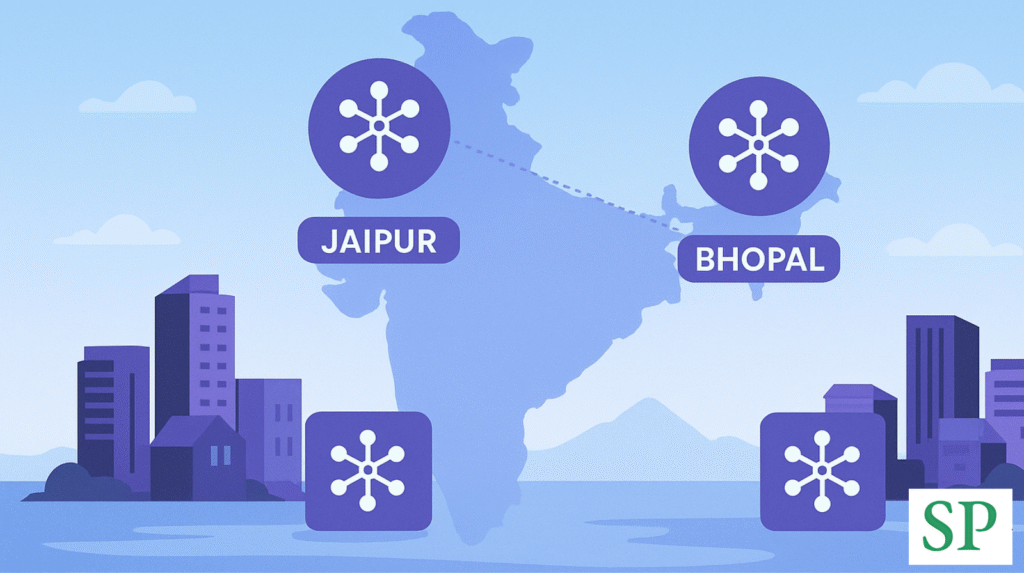For years, Bengaluru, Mumbai, Hyderabad, and Pune, the coastal megacities, have been dominating India’s technology map. However, with time, talent, and delivery hubs like Xebia, consulting firms, and global IT are shifting towards Tier-2 of India, which is making Jaipur and Bhopal India’s first AI-first Hubs.
These hubs are now reshaping how enterprise AI gets sustained, built, and scaled in the country. This was started as a delivery capacity distribution, but has now transformed into a strategic play. Tier-2 centres are now more than the cheaper satellites; they are competitive, superior, and the coastal giants. ETHRWorld.com+1
Why Jaipur and Bhopal are cheap rent & Xebia preferred
Lower office rents and compensation bands can stretch hiring budgets, but cost alone doesn’t explain Xebia’s concentrated push. The classical argument for Tier-2 expansion is cost arbitrage. Jaipur and Bhopal bring advantages that matter exponentially for AI work. These are –
a) Strong Technical education pipelines,
b) Grown Local Ecosystems of startups and service firms, and
c) Talent pools with Domain Knowledge relevant to India’s digitalization push, such as Finance, Government Services, and E-commerce.
Xebia framed this in its India strategy. The company sees tier-2 cities as sources of specialized, loyal talent. It has publicly expanded its operations in these cities to tap local potential.

Xebia focuses on Transformation Hubs from centres of delivery to AI-First
Rather than outsourcing routine tasks, Bhopal and Jaipur are now running cross-functional squads that prototype AI proof-of-value projects, ship production ML pipelines, and collaborate with client product teams worldwide. That shift from “capacity” to “capability” is the strategic pivot that lets Tier-2 centres meaningfully rival coastal competitors.
With time, Xebia’s language around these cities has transformed. Initially announced as “technology hubs” for delivery, the Jaipur site, inaugurated in 2023, and Bhopal operations have been positioned as AI-first transformation centres where applied GenAI, data engineering, and cloud-native practices come together.
Xebia follows – Deep Hire, Better Retains.
Xebia was assisted by two practical forces here, in India.
- The first one is The Depth: Jaipur and Bhopal sit close to numerous engineering colleges and regional universities, so the candidate funnel is vast and increasing in AI awareness.
- The Second one is Retention: Employees in Tier-2 cities often show higher tenure and local anchor preferences (family, housing affordability, lower commute stress). Retention is as valuable as raw hiring volume for firms scaling AI teams, where continuity, institutional knowledge, and long-tail model maintenance matter the most. Xebia has signalled aggressive hiring goals tied to these two hubs, reflecting confidence in supply.
Practical advantages for AI productization
It’s 2025 now, and the whole world, including the government, has accepted AI. AI projects thrive depending on three operational levers: Iterative Engineering, Data Access, and Domain Feedback. Tier-2 hubs offer unique strengths here, like:
- Domain proximity –
Many Tier-2 cities are closer to local enterprises, state governments, and regional banks. Proximity pays for AI solutions in governance, agritech, or regional commerce. - Data stewardship –
Teams close to stakeholders and data sources apparently move faster from PoC to production because feedback cycles are shorter. - Cost-efficient experimentation –
Rather than Headline Locality, one should focus on running numerous model experiments, annotating datasets, and spinning up infrastructure costs less when your engineering and ops footprint is optimized for values.
Building the AI Stacks –
Xebia is investing in capability building and planting offices. The firm has publicly emphasized AI skilling, academy programs, and local hiring pushes to create a continuous supply of applied ML engineers, MLOps practitioners, and cloud architects. Strategic partnerships (both with platform vendors and local institutes) help accelerate on-the-job learning.
It requires Ecosytem to upgrade a city’s tech profile, as it can’t be done instantly. University Tie-Ups, Meetups, Bootcamps, and Client projects that create a virtuous loop. Signals are in favour as Jaipur and Bhopal are already cultivating that ecosystem, which shortens the runway to becoming self-sustaining AI clusters.
Competitive pressures on the Coastal Giants
Competitive pressures aren’t just limited to humans and cities like Bengaluru and Hyderabad. For them, it’s crucial. First, they’ll still own deep pools of senior AI research talent and a richer startup ecosystem. Second, coastal centres will face pressure on talent retention, margins, and scale timelines. Companies that distribute workloads, design strategic products in Bengaluru, and provide cost-effective model training and operations in Jaipur/Bhopal will capture the best creativity and efficiency globally.
This offers clients a new procurement playbook: multi-hub delivery models. In these models, mission-critical innovation stays with center-of-excellence teams while iterative engineering and maintenance live in Tier-2 hubs. This model can reduce time-to-market and production costs without sacrificing quality.
Risks and Solutions
No shift is frictionless. Scaling AI responsibly in Tier-2 cities poses challenges like building advanced senior leadership locally, ensuring high data privacy and model governance standards, and avoiding a two-tier quality perception across hubs. Xebia or any company attempting this play must invest in uniform processes, rotational leadership programs, and centralized governance to keep standards consistent across geographies.
Including this, infrastructure gaps (high-performance compute availability, low-latency networking, and local cloud footprints) must be addressed through partnerships or centralized provisioning to ensure production-grade AI systems run reliably.
India’s Decentralized AI Future
When global consultancies build AI capability outside the top metros, it democratizes opportunity: regional talent gets global projects, local economies absorb higher-skilled jobs, and enterprise AI benefits from diverse perspectives rooted in the local context. Xebia’s play is emblematic of a larger national trend. As enterprises and vendors rethink resilience and cost in the post-pandemic world, India’s Tier-2 cities are not merely feeder markets but are becoming creators.
Suppose Jaipur and Bhopal keep scaling quality outcomes, and firms follow suit. In that case, India will see a multipolar tech geography where innovation flows from many nodes rather than a handful of megacities. That’s good for companies, workers, and the market as a whole.
Blueprint for rivals and clients
Jaipur and Bhopal are not overnight miracles; they result from deliberate hiring, community building, and strategic investment. But the signal is strong: Tier-2 hubs can — and will — rival coastal giants on AI impact, not just cost. Expect more firms to follow Xebia’s playbook, and more cities to join the new map of India’s AI economy.
Xebia’s Tier-2 AI strategy offers a clear blueprint: Identify regional strengths, invest in skilling and governance, and run a hybrid delivery model that pairs coastal R&D with Tier-2 execution.
The lesson for rivals is simple: Ignoring Tier-2 India cedes talent, cost advantage, and outcomes.
For enterprise buyers, the opportunity is even clearer: Demand AI delivery models that are outcome-oriented, not location-bound.
Follow me on my Instagram Writer Profile – Siddhant Jain SJ – The Writer
My Previous Blog for Solsaga – Blog

